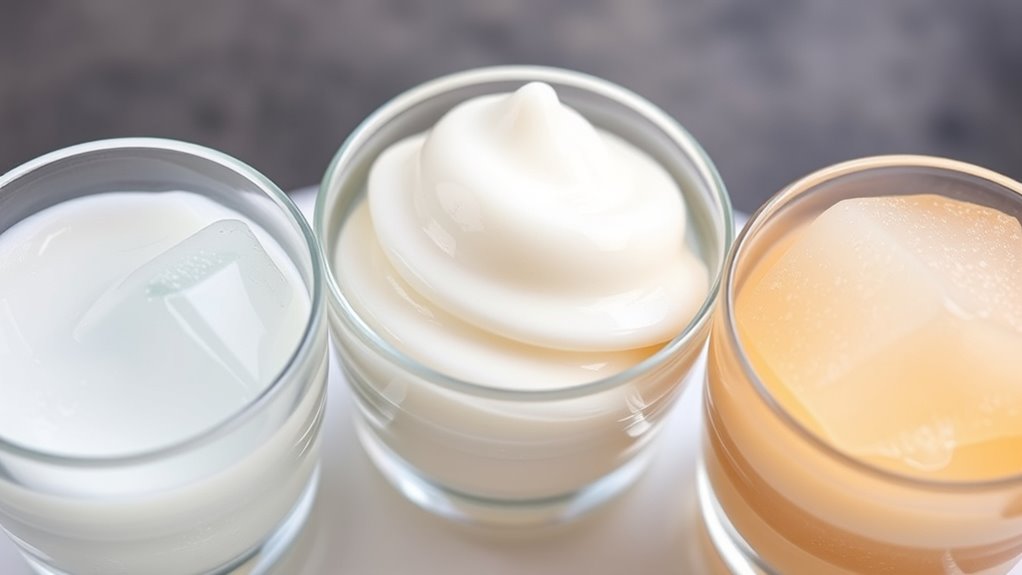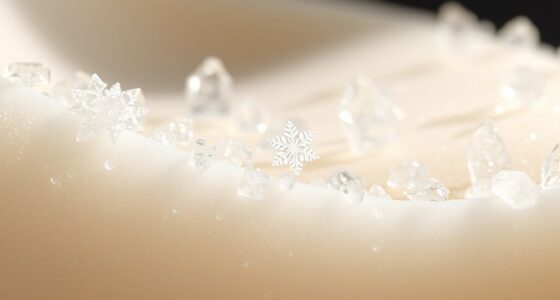To fine-tune your gelato’s texture and flavor, choose between glucose, sucrose, and dextrose carefully. Glucose and dextrose promote smoothness and prevent crystallization, keeping your gelato silky. Sucrose adds balanced sweetness and enhances flavors but tends to crystallize if not managed properly. Combining these sugars can optimize the texture and taste, ensuring a delightful treat. Keep exploring to discover how these sugars work together for perfect gelato consistency.
Key Takeaways
- Glucose and dextrose prevent crystallization, ensuring a smooth, silky gelato texture, while sucrose may cause graininess if not managed properly.
- Sucrose provides balanced sweetness and flavor enhancement but tends to crystallize during freezing, requiring careful handling.
- Glucose and dextrose offer subtler sweetness, supporting delicate flavors and maintaining stability without overpowering ingredients.
- Combining these sugars allows fine-tuning of texture and flavor, balancing creaminess, sweetness, and crystallization control.
- Choice of sugar depends on desired gelato characteristics: glucose/dextrose for smoothness, sucrose for richer sweetness and flavor depth.

When it comes to gelato, understanding its sugar profile is vital for appreciating its flavor and texture. The types of sugars you choose—glucose, sucrose, or dextrose—directly influence how the gelato turns out, especially in terms of sugar crystallization and flavor enhancement. Each sugar interacts differently with the other ingredients, shaping the final product’s smoothness and taste.
Glucose, also called dextrose, is a simple sugar that dissolves quickly and has a low tendency to crystallize. Using glucose in your gelato helps prevent unwanted sugar crystallization, which can cause a gritty texture. It also contributes to a clean, sweet flavor without overpowering the other ingredients. Since glucose has a lower sweetness level compared to sucrose, adding it allows you to fine-tune the overall sweetness without risking a syrupy or overly sweet profile. Its rapid dissolving property ensures a uniform sweetness and smooth mouthfeel, making it a popular choice for achieving a silky texture.
Sucrose, or table sugar, is the most commonly used sweetener in gelato. It provides a balanced sweetness and enhances flavor by suppressing bitterness in ingredients like cocoa or coffee. However, sucrose has a higher tendency to crystallize during freezing, which can sometimes lead to a gritty or grainy texture if not managed properly. To mitigate this, gelato makers often combine sucrose with other sugars or use specific freezing techniques. When used correctly, sucrose amplifies the flavor nuances, making the fruit, chocolate, or other flavors pop. Its ability to dissolve slowly and form a stable crystalline structure can also help in controlling the texture, giving you a creamy, consistent mouthfeel.
Dextrose, essentially the same as glucose, is favored for its ability to reduce sugar crystallization and improve texture. Its subtle sweetness and quick solubility make it ideal for delicate flavor profiles where you want the sweetness to support rather than overpower. Dextrose’s influence on sugar crystallization helps keep the gelato smooth, while also aiding in flavor enhancement by allowing other flavors to shine through without overshadowing them.
Choosing the right sugar profile depends on your desired texture and flavor outcome. Glucose or dextrose help create a stable, smooth gelato with minimal crystallization, while sucrose offers a classic sweetness and flavor enhancement. Combining these sugars thoughtfully allows you to fine-tune your gelato’s sensory qualities, ensuring a delightful, perfectly textured treat every time.
Frequently Asked Questions
How Does Sugar Type Affect Gelato Freezing Point?
You might notice that the sugar type affects gelato’s freezing point because different sugars influence how low the temperature drops during freezing. For example, glucose lowers the freezing point less than sucrose or dextrose, meaning it keeps the gelato softer. The sugar concentration also plays a role; higher amounts further depress the freezing point, resulting in a creamier texture. So, selecting the right sugar type and amount helps you control gelato’s consistency and freezing behavior.
Can Sugar Profile Influence Gelato Shelf Life?
You might wonder if sugar profile influences gelato shelf life. It does, as different sugars impact sugar stability and microbial growth. For example, sucrose generally offers better stability, delaying spoilage, while glucose and dextrose can promote microbial growth if not properly managed. Choosing the right sugar profile helps extend shelf life, ensuring your gelato remains fresh and safe for longer periods.
Are There Health Benefits to Using Specific Sugars in Gelato?
Considering the health benefits of specific sugars in gelato, you might find that choosing ingredients like glucose or sucrose can impact your sugar metabolism positively. Some sugars digest more slowly, helping maintain steady blood sugar levels and reducing energy crashes. By selecting these sugars wisely, you support better health while still enjoying your favorite treat. Always balance indulgence with mindful choices for supreme health benefits.
How Does Sugar Choice Impact Gelato’s Texture Over Time?
When you choose different sugars, you influence gelato’s texture over time. For example, sucrose helps prevent crystal formation, maintaining smoothness longer, while glucose can enhance mouthfeel and reduce freezing point depression. Dextrose may lead to quicker crystallization, affecting texture. Your choice impacts how the gelato feels and stays creamy, so selecting the right sugar guarantees a consistent, enjoyable experience with ideal mouthfeel and minimal crystal development.
Can Alternative Sweeteners Replace Traditional Sugars in Gelato?
You might wonder if natural sweeteners or artificial alternatives can replace traditional sugars in gelato. Yes, they can, but you need to contemplate how each impacts texture and flavor. Natural sweeteners like honey or agave bring unique profiles, while artificial alternatives may alter consistency. Experimenting helps you find the right balance, ensuring your gelato remains creamy and delicious without sacrificing quality.
Conclusion
So, next time you marvel at that perfectly balanced gelato, remember it’s all about the subtle dance between glucose, sucrose, and dextrose. You’d think mastering sweetness was straightforward, but fine-tuning these profiles reveals just how much science goes into your indulgence. Ironically, the secret to a flawless scoop lies not in exotic ingredients but in understanding these humble sugars—proving that sometimes, simplicity is the sweetest sophistication.









